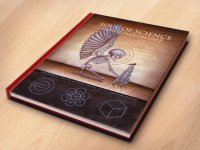| Science and Spirit: The Art of Daniel Martin Diaz |
|
|
“The greatest minds and creators have led us through history and have placed upon us a foundation for greatness, an ambition to strive for the best humanity can achieve; yet still we search,” writes Paula Catherine Valencia in her essay “Map of the Soul” in Soul of Science, a new book of artwork by her husband, Daniel Martin Díaz. Scientists may be no more adept at elucidating the meaning of existence than artists, who also investigate the unknown using their various mediums. For Díaz, that medium is drawing. Soul of Science, published in 2013 by the couple’s own Mysticus Publishing (www.sacredmachine.com), explores the mysteries of science with a collection of essays by professionals working in such fields as physics, mathematics, chemistry, and bioengineering.
Díaz’s graphite drawings do not serve as illustrations for the text. It’s the other way around; the text tackles themes reflected in the artwork. For instance, bioengineer Greg L. Golden explores hierarchies in the structure of Díaz’s Spirit Machine. The work depicts a man lying on his back who’s connected to a symmetrical, mandala-like constellation of spheres by a series of interwoven lines. The man lies at one end of the spectrum of a hierarchy, and at the other end is a vision of the divine spirit that animates him. At least, that’s one reading. Golden writes that the “circuit” depicted in Spirit Machine “represents the act of computation or transmutation of the spirit into the human lying supine at the bottom of the picture.”
Spirit Machine is one of a number of diagrammatic images that have the appearance of schematics describing inner states of being. Díaz’s work is an artistic interpretation of scientific, philosophical, and spiritual ideas, often merged into a single image. Mysteries of the Universe, for example, incorporates a geometric diagram, at the center of which is an eye — perhaps representing the all-seeing eye of God. Beneath this vision is a tree against the backdrop of a field of stars. An angel appears on one side of the tree and a demon on the other, like something from a medieval illuminated manuscript. The juxtaposition of angel and demon and the overall symmetrical composition suggest duality or a balance of opposites. The imagery is from Christian tradition. In his accompanying essay, “The Evolution of Perceptive Dualism,” research scientist David Walker writes, “Our cognitive evolution will rely upon reconciling art, science, and religion into a seemingly mystical but singular truth.” Díaz’s illustrations are visual representations of such a reconciliation.
Quite a few images in Soul of Science convey a sense of the interconnectedness of mind, body, and spirit. Atomism, for instance, shows a human figure pocked with eyes over most of his body. The eyes suggest a consciousness or awareness that permeates the figure’s entire being. “What is consciousness anyway?” Chris Duffield asks in his associated essay, “Magnum Mysterium: Science, Technology, and Consciousness.” He suggests that consciousness is something interwoven through, or permeating, all of nature.
Díaz’s Faith in the Algorithm shows the face of Christ with a series of lines branching outward with greater and greater complexity from his forehead, where a third eye might be. Perhaps it suggests that from one come many. Many of the drawings in the book show geometic configurations with eyes at their centers or pinnacles, rendered much like the eye in the pyramid on the back of a one-dollar bill.
In selecting and commissioning the texts for Soul of Science, Díaz took an interdisciplinary approach. A greater vision of truth can be gleaned from examining questions — such as the one posed by Duffield — when we see areas of agreement between theories that approach the same problems from the perspective of different disciplines. That is one strength of Soul of Science. The drawings are another — a blend of steampunk, architectonic structures, and mystical flights of fancy.
Captured Soul has no mathematic configurations or scientific references, but it equates the soul with bird imagery, in keeping with iconography going at least as far back as ancient Egypt, where the human soul was often depicted as a winged figure. The drawing shows a soul (represented by a bird) trapped in a cage made from tendrils branching from a being who looks part human and part tree.
Explaining his inspiration for the book, Díaz states that he created the drawings “without any leanings towards aesthetics,” but there is, in fact, an aesthetic that permeates this body of work — one rooted in medieval demonology, 19th-century illustration, and religious iconography. Díaz’s vision is not merely antiquarian or old-fashioned. Many references to contemporary technological systems, including the internet and computer programming, permeate the book. The banner above an image of Christ’s crucifixion, called Binary Christ, contains what appears to be a string of binary code rather than the traditional Latin inscription that translates as “Jesus the Nazarene, King of the Jews.” The inclusion in several drawings of Platonic solids and sacred geometry, which lends symbolic meaning to geometric shapes, proportions, and configurations, could be references to patterns in nature that exist independently of human thought and experience.
Soul of Science manages to be revealing and mysterious at the same time, with provocative essays that validate Díaz’s artistic vision, which gives visual expression to the persistent idea that god is a circle whose center is everywhere and circumference nowhere. ◀
Daniel Martin Díaz is represented exclusively in Santa Fe by Pop Gallery. |
|
|
|



